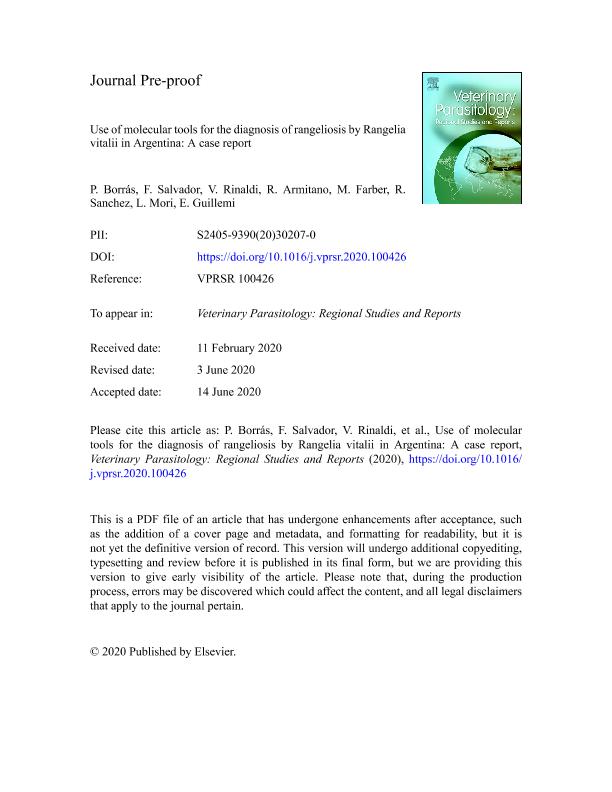Artículo
Use of molecular tools for the diagnosis of rangeliosis by Rangelia vitalii in Argentina: A case report
Borrás, Pablo Jesús; Salvador, F.; Rinaldi, V.; Armitano, Rita Ines ; Farber, Marisa Diana
; Farber, Marisa Diana ; Sanchez, R.; Mori, L.; Guillemi, Eliana Carolina
; Sanchez, R.; Mori, L.; Guillemi, Eliana Carolina
 ; Farber, Marisa Diana
; Farber, Marisa Diana ; Sanchez, R.; Mori, L.; Guillemi, Eliana Carolina
; Sanchez, R.; Mori, L.; Guillemi, Eliana Carolina
Fecha de publicación:
07/2020
Editorial:
Elsevier
Revista:
Veterinary Parasitology: Regional Studies and Reports
ISSN:
2405-9390
Idioma:
Inglés
Tipo de recurso:
Artículo publicado
Clasificación temática:
Resumen
Vector-borne pathogens are responsible for serious emerging diseases and Rangelia vitalii, the etiologic agent of canine rangeliosis, is one of the most pathogenic tick-borne pathogens for dogs in South America. This protozoan is transmitted by the Amblyomma aureolatum tick bite and the clinical features associated to the disease are fever, hemolytic anemia, jaundice, hepatosplenomegaly and bleeding from natural orifices, mainly from the ear egde. The reports of canine rangeliosis in Argentina are scarce. In the present study we report the detection of Rangelia vitalii in a naturally infected dog from Gualeguay, Entre Ríos, Argentina with history of tick infestation and clinical signs compatible with rangeliosis. An initial blood sample was positive to piroplasmids by blood smear examination and the molecular amplification of a fragment of the 18SrRNA gene. Sequencing of the fragment confirmed the pathogen identity. After treatment with imidocarb dipropionate, the clinical signs remitted and the blood smear tested negative.
Palabras clave:
DOGS
,
MOLECULAR DIAGNOSIS
,
PIROPLASMS
,
RANGELIA VITALII
Archivos asociados
Licencia
Identificadores
Colecciones
Articulos (IABIMO)
Articulos de INSTITUTO DE AGROBIOTECNOLOGIA Y BIOLOGIA MOLECULAR
Articulos de INSTITUTO DE AGROBIOTECNOLOGIA Y BIOLOGIA MOLECULAR
Citación
Borrás, Pablo Jesús; Salvador, F.; Rinaldi, V.; Armitano, Rita Ines; Farber, Marisa Diana; et al.; Use of molecular tools for the diagnosis of rangeliosis by Rangelia vitalii in Argentina: A case report; Elsevier; Veterinary Parasitology: Regional Studies and Reports; 21; 7-2020; 1-15
Compartir
Altmétricas



